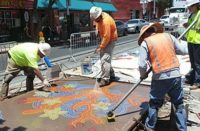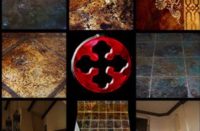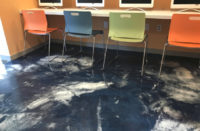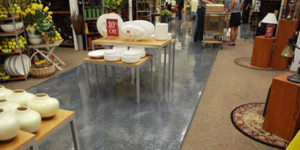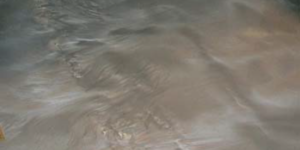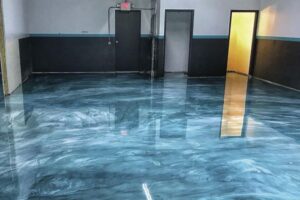Decorative epoxies for colorful garage floors burst onto the scene in the 1970s, when applicators began to saturate chemical-resistant epoxy coatings with colored vinyl chips. These floors went out of style for a while, but General Polymers director of floor coatings Lonnie Salyers says they are making a comeback, and not just in garages. The same chemical resistance and colorful aesthetics that make them popular in garages are now valued in showrooms, restaurants and schools.
Contractors can either add a few chips to the mix or flood the floor with them for denser color. What’s more, Salyers points out that whatever final look you settle on is easy to change later. “Just abrade the old surface to remove the gloss and then apply another epoxy layer and broadcast chips in another color for a whole new look.”
What’s more, the color chips themselves are becoming high-tech. For example, H & C Concrete Coatings offers hexagon-shaped holographic flakes that add sparkle to the floor. “They shimmer almost like a diamond reflective,” says H & C product manager Justin Brazie. They can be used alone, but Brazie recommends the applicator spread them randomly along with regular paint flake colors.
Color chips are not the only things contractors are adding to epoxy coatings. “Since epoxies are such excellent adhesives, various materials can be added to epoxy systems for decorative purposes,” says Westcoat’s Paul Koury. “Some examples are pebbles, colored sand, glass and marble chips.”
Another innovation is brightly colored metallic epoxies. Metallic pigments can be added on-site. Westcoat Specialty Coating Systems has advanced this technology in its new Liquid Dazzle coating by premixing the pigment with the company’s epoxy resin for better consistency. The metallic additives uniquely flow when applied, producing a color-changing effect, according to the Westcoat Web site.
Contractor Craig Adamson likes the look of epoxy coatings over acidstained concrete. “One hundred percent solids epoxies really bring out vibrant acid stain colors,” he says. He also likes using water-based emulsions because they breathe and let moisture escape without chalking. The topcoat of the system is a wear surface that the end user can easily reapply when it begins to dull. He cautions that all the acid residue must be completely removed to ensure good adhesion. “Do a white-glove test,” he says.

A new opaque epoxy coating mimics the look of acid stain, but with greater control and consistency. The three-coat pigmented coating system from Thermal-Chem Corp. starts with a typical clear epoxy primer and finishes with a urethane topcoat for scratch resistance, low maintenance and UV protection.
It is the opaque epoxy second coat that gives the effect. This material is factory-tinted to guarantee consistent color from batch to batch. The contractor then has substantial leeway in making the color dynamic. By moving the material around on the floor, the contractor can create the same variations that make acid stain so attractive, says Scott Schemmel, in technical sales for Thermal- Chem. Artisans have used blowers, dispersing agents and textured rollers to animate the color, he reports.
And because the coating is opaque, it can hide patches, repairs, zinc strips or discolored concrete, unlike an acid stain, which would leave all these flaws visible. The coating can also be applied over substrates other than concrete. Schemmel is planning to build a countertop out of wood and coat it with the new material to get a seamless concrete look at a fraction of the weight and cost.
With a track record spanning decades, from garages to concept restaurants, epoxy coatings are proven performers for decorative concrete floors. Epoxy on a concrete floor is like frosting on a cake — both functional and decorative. It protects the concrete and prolongs its life. And in the hands of a craftsman, it adds color and pizazz.
